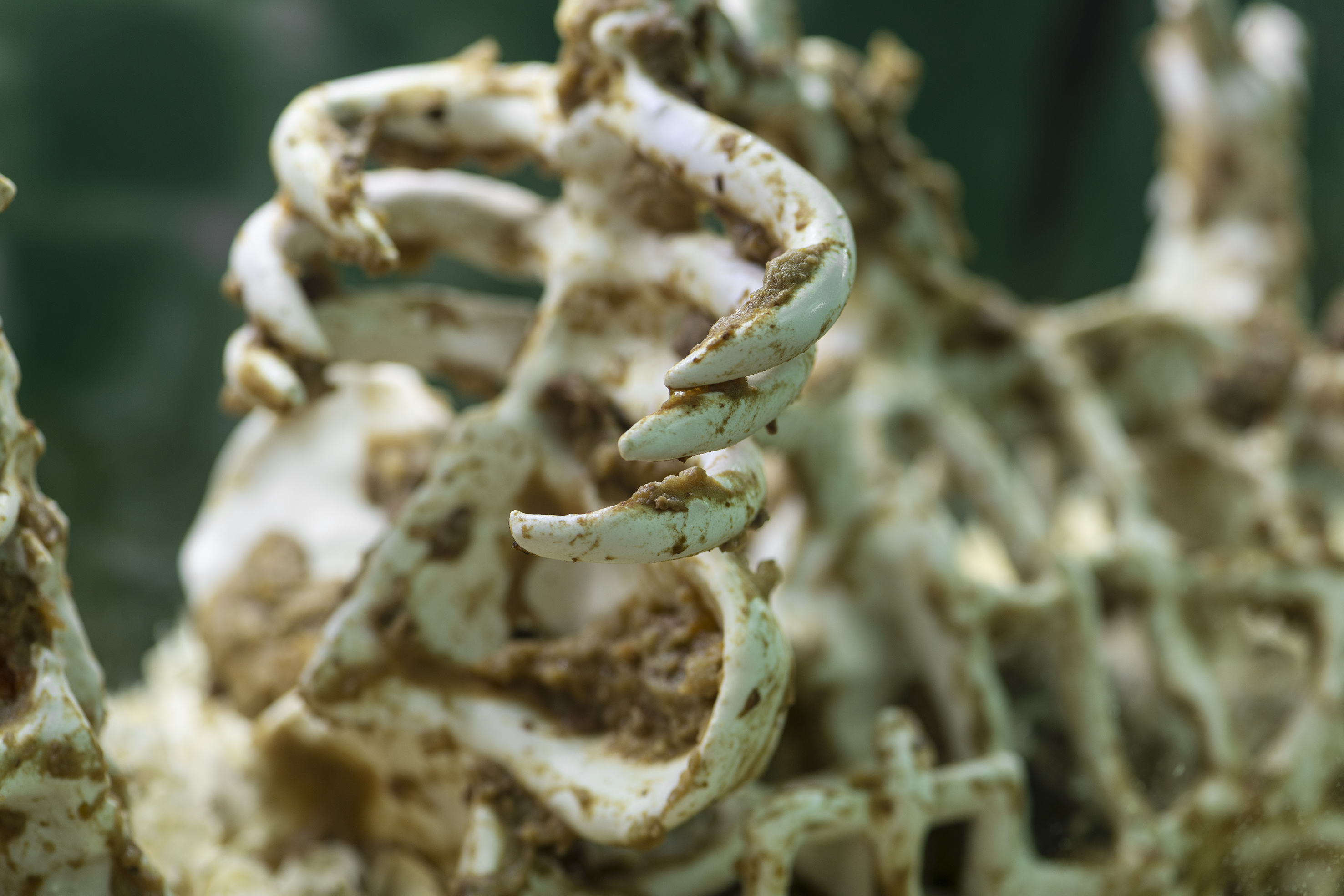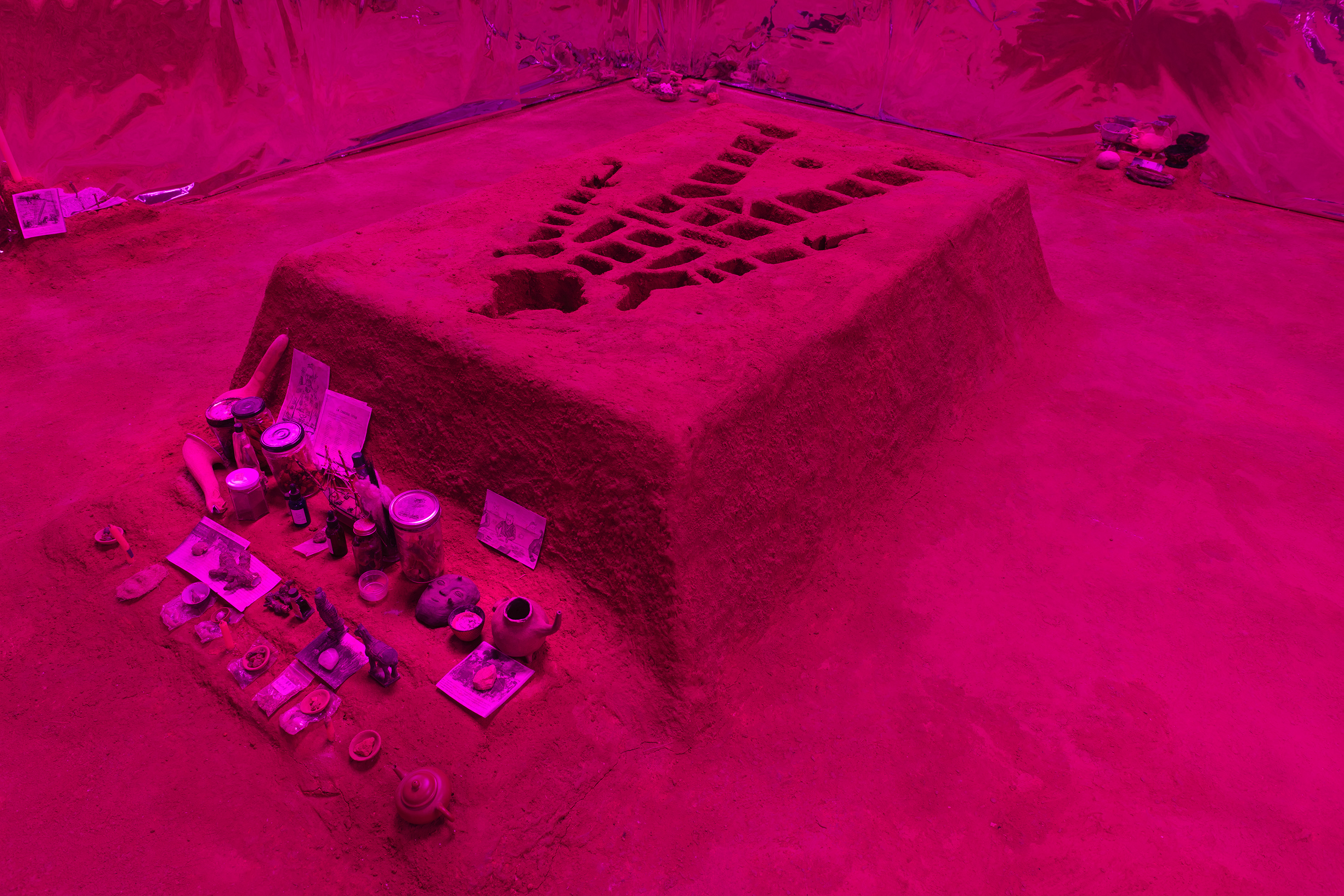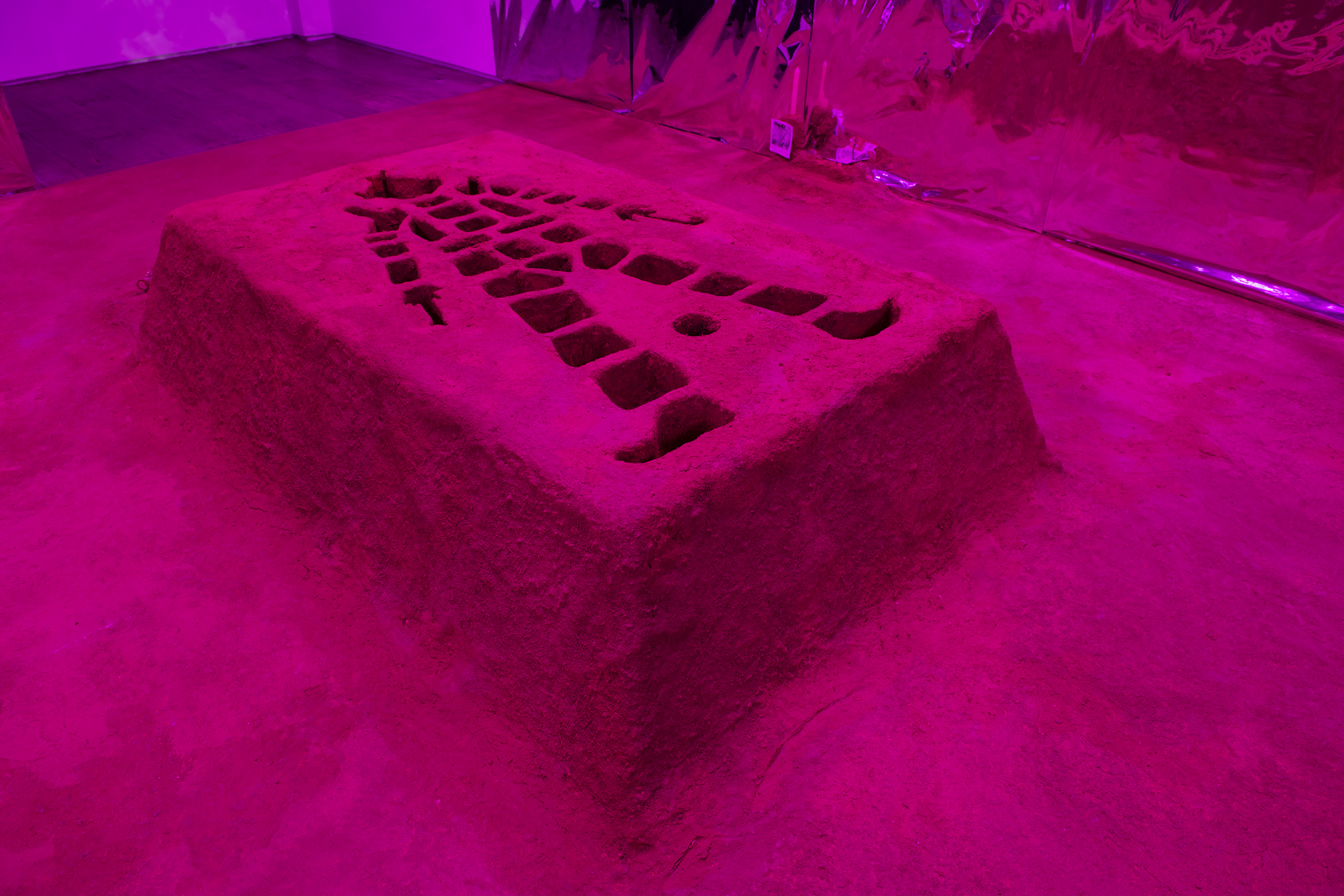

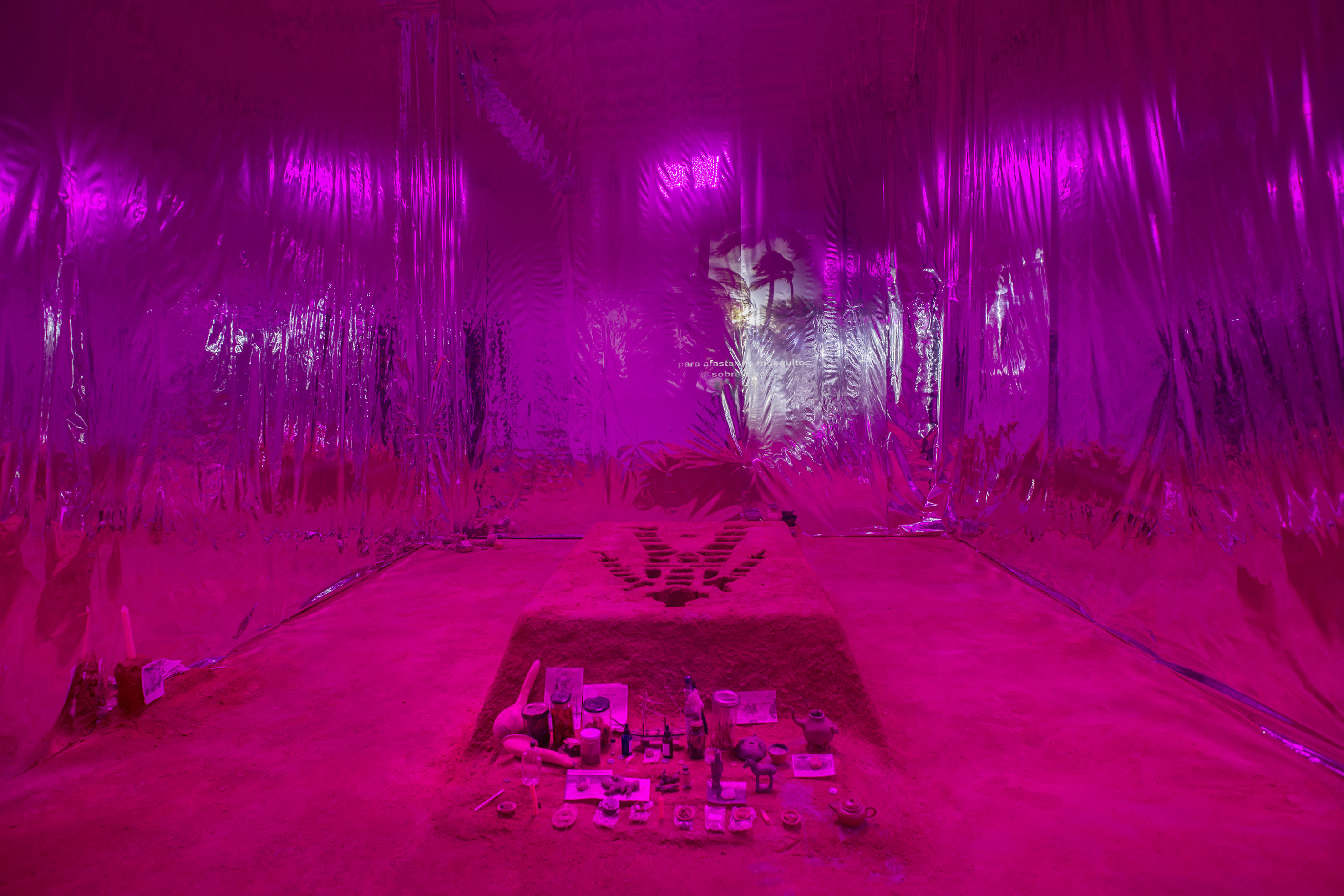

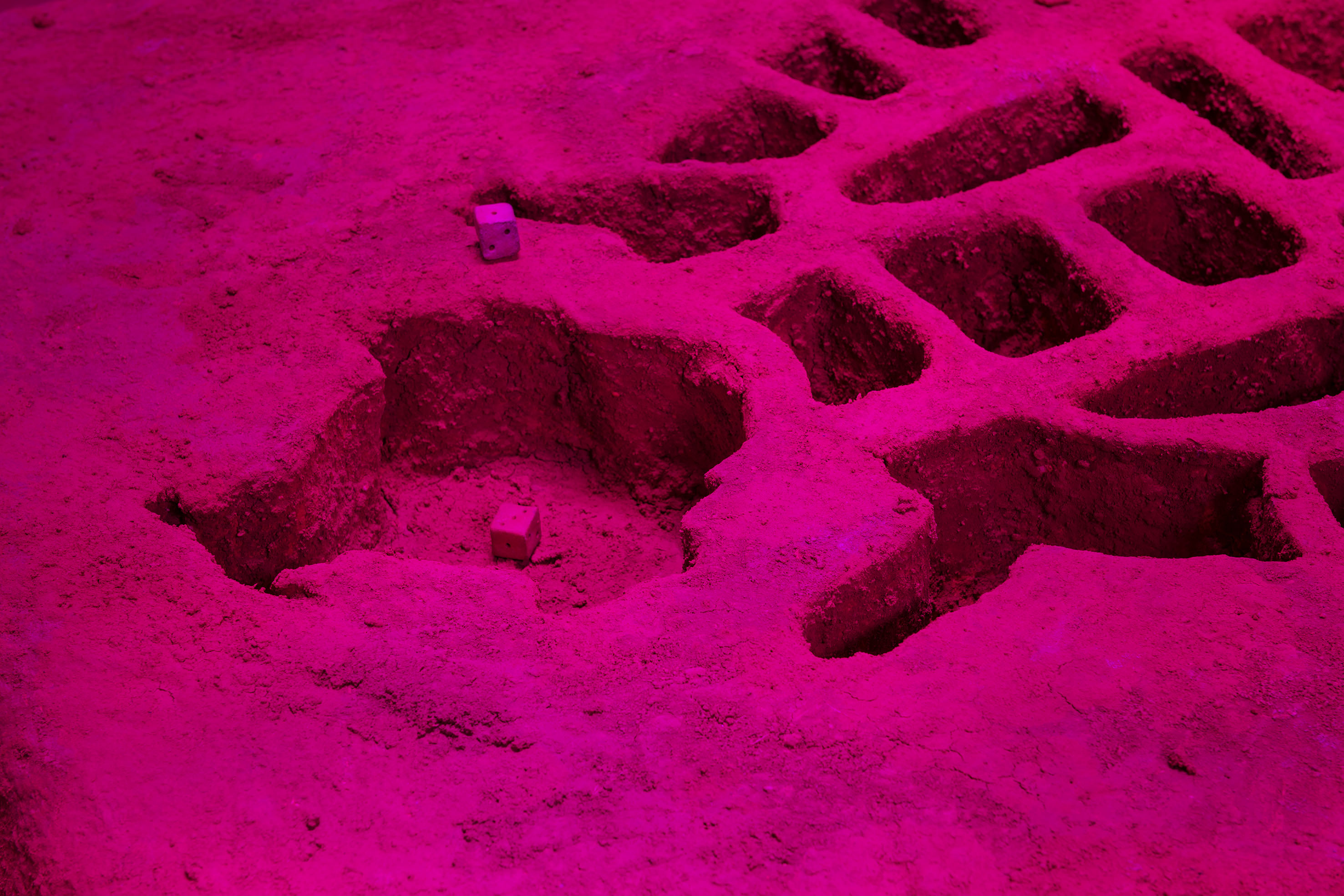


Vistas da exposição Hospitality for ghosts (2023), de Candice Lin, na Almeida & Dale, em São Paulo
Hospitality for ghosts
Texto crítico publicado na revista Carla (Contemporary Art Review Los Angeles) sobre a exposição da artista em São Paulo
WEB
Texto crítico publicado na revista Carla (Contemporary Art Review Los Angeles) sobre a exposição da artista em São Paulo
WEB
Candice Lin at Almeida & Dale, São Paulo
October 28 to December 16, 2023
In the 19th and 20th centuries, thousands of Chinese immigrants were brought to the Caribbean and Latin America to work as laborers following the abolition of black slavery, the first of many waves of Asian immigrants. In Hospitality for Ghosts, Candice Lin’s first solo show in Brazil, the LA-based artist explores subjects pertinent to this colonial history––such as sugar production by enslaved laborers and the presence of the coolie. [1] The show, hosted by Almeida & Dale in São Paulo, combines porcelain and fiberglass sculptures with audio, documentary videos, and an immersive and interactive installation. Through this varied production, Lin gestures to larger histories of the Asian diaspora in places like Cuba and Brazil, highlighting stories of resistance and hybridity. Lin challenges Eurocentric epistemologies that aim to standardize bodies, cultures, beliefs, and ways of living, where anyone deemed other is categorized as a threat. This path counters colonial logic and leads to broader visions of Brazilian society and its colonial history, bringing the Asian diaspora into relationship with the country’s Indigenous and Afro-diasporic ways of thinking.
Since Brazil has one of the world’s largest communities of Asian immigrants and descendants, Lin’s exhibition invites Brazilian audience into a dialogue that is urgent and needed. Her show is part of Transoceanic Perspective, launched by Almeida & Dale and curated by Yudi Rafael, the most prominent researcher of the Asian diaspora in Brazil. The research and exhibition project explores the migrant movements and cultural exchanges between the Atlantic and the Pacific. Lin’s show inaugurated the program along with Mario N. Ishikawa’s Archeological Site, a simultaneous, adjacent exhibition.
Hospitality for Ghosts took up three rooms of Almeida & Dale. The first room showcased Refined by Fire (2018/2023), an installation in which Lin juxtaposed two antagonistic images. A diagram of a sugar refinery and contrasted an excerpt from the Cuban Commission, an 1873 petition written by Chinese workers. Painted on a black wall, white barrels filled with charcoal purifying granules were shown turning “brown” into “white,” as part of the refining process, mirroring the colonial efforts to culturally whiten invaded countries. The diagram also showcases chemical procedures performed by the laborers: filtering, decanting, disinfecting, sterilizing, purifying. Across the room, a fragment of the petition, which denounced ruthless working conditions, was printed on a white wall. This portion of the document described deceased workers denied the dignity of a coffin or grave. Their bodies were tossed in a pit and their bones were burnt to make lime used to refine sugar. Taken together, the contrasting images tell a striking, and unnerving, story: sugar, changed from brown to white, had a higher value than the Chinese workers. Even when they were dead, their mortal remains were violated, their ashes “refined by fire” (as the work’s title illuminates) and reinserted into the production chain. Provocatively, Lin cited these dynamics by mixing a black pigment produced from charred animal bones into the mural paint.
The installation La charada china (2018/2023) occupied another room where reflective film covered pink-lit walls. Visitors were invited to play a dice game on a central clay sculpture while ethereal footage played across the reflective walls. The work’s title nods to the gambling game popular in Cuba, introduced by 19th century Chinese immigrants when they arrived for forced labor. According to a booklet about the game, included in the installation, visitors can play La charada china “for money” or “for dreams and spirits.” Dice could fall through carved indentations in the clay table, which together evoked the shape of an absent human body. Its form recalled the figure printed on Cuban lottery tickets, a derogative image of an Asian immigrant with an opium pipe wearing clothing typical of the Qing dynasty. [2] By highlighting this game, Lin underscores the blending of Asian influences with Latin American ones, resulting in a contaminated epistemology that resists the European sense of purity.
In a smaller room, lit only by the artwork, Decomposition (2019) comprised porcelain-crafted skeletons of fabulated beings arranged in zoo-like glass cases and bathed in white LED lab lights. These mimetic vertebrae were coated in meat paste, moldering because of the Dermestidae larvae Lin placed on the artworks. In this way, the artist transformed the scientific lab experiment, a symbol of colonial logic and control, into a spontaneous ecosystem of fake bones and larvae that were fascinating to watch. I visited the exhibition twice, and what I remember most was the smell. At the opening, I could see larvae discreetly crawling in the wood chips, and the work emitted a scent that reminded me of wet dog food. Two weeks later, the artwork had metamorphized almost completely. It now had a stinging acidic odor and countless beetles were dwelling inside the porcelain skeletons as if in a natural topography.
Hospitality for Ghosts implies a receptiveness to typically feared phenomena. [3] In embracing hybridity and syncretism, Lin’s exhibition viscerally refuses the colonial practices of categorizing, segregating, and purifying. It honors impurity, exploring harmonic possibilities of contamination, and welcoming the haunted as enriching matter.
Notes
[1] To offset the enslaved labor crisis caused by the abolition of African slavery, coolies were Chinese people “brought to the Caribbean since the early 19th century to harvest sugar cane, tobacco and batshit; to make bricks from clay and cement; to mine minerals and metals.” Candice Lin, “La Charada China”, Mario Ishikawa: sítio arqueológico; Candice Lin: hospitalidade aos fantasmas, org. Yudi Rafael (São Paulo: Almeida & Dale, 2023), 48.
[2] Similar games were popular in Latin America, such as whe-whe in Trinidad and Tobago, chifatay in Peru, and zihua in the Caribbean. Ibid, 110.
[3] It can also relate to the reading of America by Chinese immigrants as a “land without ghosts,” defined by its lack of fear and shallow traditions, as depicted in the book by R. David Arkush and Leo O. Lee, Land without ghosts: Chinese impressions of America from the mid-Nineteenth century to present (Berkeley/Los Angeles/London: University of California Press, 1989).
Texto originalmente publicado na Carla #36, em 21 de maio de 2024
October 28 to December 16, 2023
In the 19th and 20th centuries, thousands of Chinese immigrants were brought to the Caribbean and Latin America to work as laborers following the abolition of black slavery, the first of many waves of Asian immigrants. In Hospitality for Ghosts, Candice Lin’s first solo show in Brazil, the LA-based artist explores subjects pertinent to this colonial history––such as sugar production by enslaved laborers and the presence of the coolie. [1] The show, hosted by Almeida & Dale in São Paulo, combines porcelain and fiberglass sculptures with audio, documentary videos, and an immersive and interactive installation. Through this varied production, Lin gestures to larger histories of the Asian diaspora in places like Cuba and Brazil, highlighting stories of resistance and hybridity. Lin challenges Eurocentric epistemologies that aim to standardize bodies, cultures, beliefs, and ways of living, where anyone deemed other is categorized as a threat. This path counters colonial logic and leads to broader visions of Brazilian society and its colonial history, bringing the Asian diaspora into relationship with the country’s Indigenous and Afro-diasporic ways of thinking.
Since Brazil has one of the world’s largest communities of Asian immigrants and descendants, Lin’s exhibition invites Brazilian audience into a dialogue that is urgent and needed. Her show is part of Transoceanic Perspective, launched by Almeida & Dale and curated by Yudi Rafael, the most prominent researcher of the Asian diaspora in Brazil. The research and exhibition project explores the migrant movements and cultural exchanges between the Atlantic and the Pacific. Lin’s show inaugurated the program along with Mario N. Ishikawa’s Archeological Site, a simultaneous, adjacent exhibition.
Hospitality for Ghosts took up three rooms of Almeida & Dale. The first room showcased Refined by Fire (2018/2023), an installation in which Lin juxtaposed two antagonistic images. A diagram of a sugar refinery and contrasted an excerpt from the Cuban Commission, an 1873 petition written by Chinese workers. Painted on a black wall, white barrels filled with charcoal purifying granules were shown turning “brown” into “white,” as part of the refining process, mirroring the colonial efforts to culturally whiten invaded countries. The diagram also showcases chemical procedures performed by the laborers: filtering, decanting, disinfecting, sterilizing, purifying. Across the room, a fragment of the petition, which denounced ruthless working conditions, was printed on a white wall. This portion of the document described deceased workers denied the dignity of a coffin or grave. Their bodies were tossed in a pit and their bones were burnt to make lime used to refine sugar. Taken together, the contrasting images tell a striking, and unnerving, story: sugar, changed from brown to white, had a higher value than the Chinese workers. Even when they were dead, their mortal remains were violated, their ashes “refined by fire” (as the work’s title illuminates) and reinserted into the production chain. Provocatively, Lin cited these dynamics by mixing a black pigment produced from charred animal bones into the mural paint.
The installation La charada china (2018/2023) occupied another room where reflective film covered pink-lit walls. Visitors were invited to play a dice game on a central clay sculpture while ethereal footage played across the reflective walls. The work’s title nods to the gambling game popular in Cuba, introduced by 19th century Chinese immigrants when they arrived for forced labor. According to a booklet about the game, included in the installation, visitors can play La charada china “for money” or “for dreams and spirits.” Dice could fall through carved indentations in the clay table, which together evoked the shape of an absent human body. Its form recalled the figure printed on Cuban lottery tickets, a derogative image of an Asian immigrant with an opium pipe wearing clothing typical of the Qing dynasty. [2] By highlighting this game, Lin underscores the blending of Asian influences with Latin American ones, resulting in a contaminated epistemology that resists the European sense of purity.
In a smaller room, lit only by the artwork, Decomposition (2019) comprised porcelain-crafted skeletons of fabulated beings arranged in zoo-like glass cases and bathed in white LED lab lights. These mimetic vertebrae were coated in meat paste, moldering because of the Dermestidae larvae Lin placed on the artworks. In this way, the artist transformed the scientific lab experiment, a symbol of colonial logic and control, into a spontaneous ecosystem of fake bones and larvae that were fascinating to watch. I visited the exhibition twice, and what I remember most was the smell. At the opening, I could see larvae discreetly crawling in the wood chips, and the work emitted a scent that reminded me of wet dog food. Two weeks later, the artwork had metamorphized almost completely. It now had a stinging acidic odor and countless beetles were dwelling inside the porcelain skeletons as if in a natural topography.
Hospitality for Ghosts implies a receptiveness to typically feared phenomena. [3] In embracing hybridity and syncretism, Lin’s exhibition viscerally refuses the colonial practices of categorizing, segregating, and purifying. It honors impurity, exploring harmonic possibilities of contamination, and welcoming the haunted as enriching matter.
Notes
[1] To offset the enslaved labor crisis caused by the abolition of African slavery, coolies were Chinese people “brought to the Caribbean since the early 19th century to harvest sugar cane, tobacco and batshit; to make bricks from clay and cement; to mine minerals and metals.” Candice Lin, “La Charada China”, Mario Ishikawa: sítio arqueológico; Candice Lin: hospitalidade aos fantasmas, org. Yudi Rafael (São Paulo: Almeida & Dale, 2023), 48.
[2] Similar games were popular in Latin America, such as whe-whe in Trinidad and Tobago, chifatay in Peru, and zihua in the Caribbean. Ibid, 110.
[3] It can also relate to the reading of America by Chinese immigrants as a “land without ghosts,” defined by its lack of fear and shallow traditions, as depicted in the book by R. David Arkush and Leo O. Lee, Land without ghosts: Chinese impressions of America from the mid-Nineteenth century to present (Berkeley/Los Angeles/London: University of California Press, 1989).
Texto originalmente publicado na Carla #36, em 21 de maio de 2024




